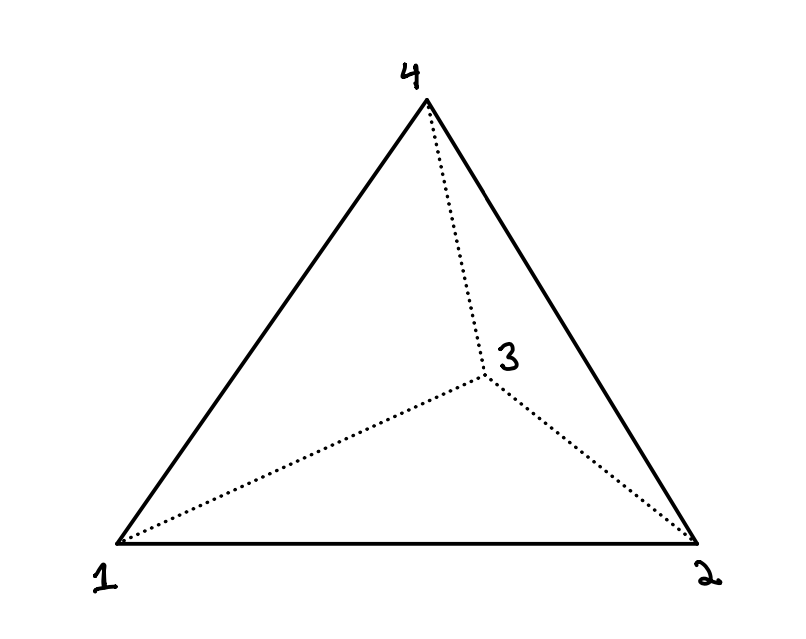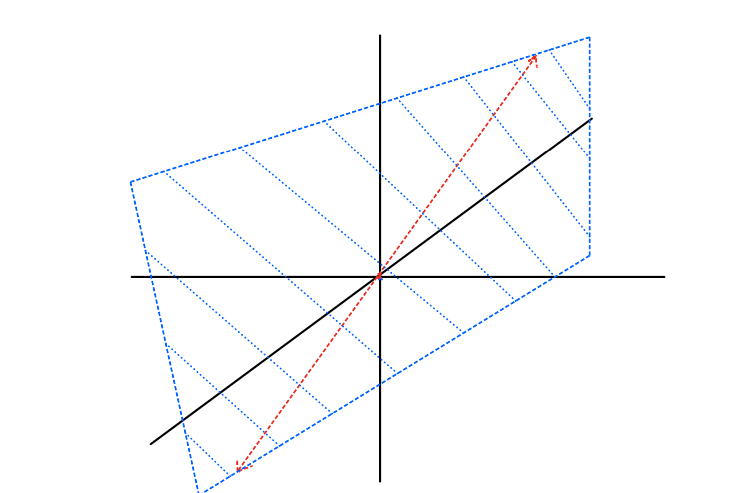Today I want to explain some algebro-geometric manifestations of the Sylow theorems. This blog post is an expansion of a Twitter Thread I wrote a few months ago, which you can find unrolled here.
The Sylow Theorems and some examples
Let’s start by reminding ourselves what the Sylow theorems say, and think about a few examples. Throughout G will be a finite group and p will be a prime.
Theorem 1. There exists a subgroup H⊂G of order a power of p such that the index [G:H] is prime to p.
Theorem 2. All such subgroups are conjugate to one another.
Theorem 3. The number of such subgroups is congruent to 1 modulo p.
Before diving into the meat of this post, let’s just work through this with a couple examples.
Example 1. Let G=S4 be the symmetric group on four letters. This group has order 24=23⋅3, so we would like to find and analyze subgroups of order 8 and 3 (which are maximal p-subgroups for p=2,3). I like to visualize S4 via its action on the tetrahedron, pictured below.
The 3-Sylow subgroups are clear visually — they are the stabilizers of the faces, generated by the rotation pictured below. There are four such (one for each face), and they are conjugate because S4 evidently acts transitively on the faces.
The 2-Sylows are a little harder to see — they’re the stabilizers of the pairs of opposite edges (colored identically below). They are generated by the reflections across the planes containing one edge and the midpoint of the opposite edge, and the “twist” which exchanges two identically colored edges. There are 3 such groups, and they are conjugate because S4 acts transitively on the set of pairs of disjoint edges.
Example 2. Let G=A5 be the alternating group on five letters; this is also the group of rotational symmetries of the icosahedron, pictured below.
The order of A5 is 60=22⋅3⋅5, so we’re looking for subgroups of order 3,4, and 5. The subgroups of order 3 and 5 are not so hard to find — they’re given by rotation about an axis through two opposite faces/vertices, respectively, as pictured below.
There are six pairs of opposite vertices, hence six 5-Sylow subgroups; they are all conjugate as A5 acts transitively on the set of vertices of the icosahedron. There are ten pairs of opposite faces, hence ten 3-Sylow subgroups; they are conjugate as A5 acts transitively on the set of faces of the icosahedron.
The 2-Sylow subgroup, of order 4, is a little harder to find. Consider a set of four faces sharing no vertices, pictured in green below. Connecting their centers gives a tetrahedron, as pictured.
The subgroup of A5 preserving the tetrahedron is isomorphic to A4, and as before, the 2-Sylow (which has order 4) is the subgroup preserving two disjoint edges of the tetrahedron.
By the way, you might wonder where the isomorphism between A5 and the group of rotational symmetries of the icosahedron arises from — it’s from the tetrahedron above. The tetrahedron was given by choosing four disjoint faces of the icosahedron; there are 5 such choices, giving rise to five inscribed tetrahedra, pictured below somewhat messily. The action of the group of rotational symmetries of the icosahedron on these five tetrahedra gives rise to the isomorphism with A5.
Example 3. Let’s think about GL3(F2), the group of automorphisms of the Fano plane, pictured below (this is the set of 1-dimensional subspaces of F32, labeled by the unique non-zero vector in the given subspace; the lines/circle represent 2-dimensional subspaces containing a given 1-dimensional subspace). This group is also isomorphic to PSL2(F7)=SL2(F7)/{±1}.
This group has order 168. To see this, note that we’re trying to count 3×3 invertible matrices over F2. The first column can be any non-zero vector; there are 23−1 choices for this vector. The second column can be any vector not in the span of the first; there are 23−2 choices. Finally, the third column can be any vector not in the span of the first two; there are 23−4 choices. So we have #GL3(F2)=(23−1)(23−2)(23−4)=168.
As 168=7⋅3⋅23, we are looking for a 7-Sylow, a 3-Sylow, and a 2-Sylow subgroup. Here a 2-Sylow subgroup is easy to find; it’s given by upper triangular matrices with one’s on the diagonal: (1∗∗01∗001).
To find the 7-Sylow, think of the units of F8 acting on F8 by multiplication. The units are a cyclic group of order 7, and F8 is a 3-dimensional F2-vector space, so choosing a basis of F8, we get a 3-dimensional F2-representation of F∗8, whose image is precisely the desired 7-Sylow.
3-Sylows work similarly; the units of F4 have order 3, and act on F4, which is a 2-dimensional F2-vector space. Writing F4⊕F2≃F32 and letting F∗4 act trivially on the rightmost factor gives a 3-dimensional representation of F∗4 whose image is one of the desired 3-Sylows. We could also take a subgroup generated by a cyclic permutation matrix, for example; both constructions generalize well, as we shall see in a future post.
The main example
The main example I’d like to discuss today is a generalization of Example 3 above. Namely, let’s think about GLn(Fq),the group of invertible n×n matrices with coefficients in Fq, for q=pr a prime power. As before, we first compute the size of this group. Again, the first column can be any non-zero vector; the second column can be any vector not in the span of the first; the third can be any not in the span of the first two, and so on. This gives
#GLn(Fq)=(qn−1)(qn−q)(qn−q2)⋯(qn−qn−1).
The easiest Sylow subgroups to find are the p-Sylows, where q is a power of p. The largest power of p dividing the order of our group is q⋅q2⋯qn−1=qn(n−1)/2, and there’s a pretty easy-to-find subgroup of this size, generalizing what happened for n=3,p=2. Namely, we can again consider the upper-triangular matrices with one’s on the diagonal:
(1∗∗⋯∗01∗⋯00⋱⋱⋮0⋯01∗0⋯001).
This kind of subgroup has a name — it’s called a maximal unipotent subgroup. Let’s describe such things geometrically.
A flag 0=F0⊂F1⊂⋯⊂Fn=V inside of a vector space V is a collection of subspaces, each contained in the next. A full flag is such a collection where each Fi has dimension i. For k a field, a maximal unipotent subgroup of GLn(k) is precisely the subgroup of the stabilizer of some flag F∙ acting trivially on Fi/Fi−1 for each i.
A full flag in R3
How many full flags (and hence how many maximal unipotent subgroups, aka p-Sylows, are there) in Fnq? I claim that there are (1+q)(1+q+q2)⋯(1+q+q2+⋯+qn−1)=n∏i=11−qi1−q. Let’s prove this by induction.
The base case where n=1 is trivial — there’s a unique full flag. Now let V be an n-dimensional vector space over Fq. Each codimension 1 subspace contains n−1∏i=11−qi1−q full flags by the induction hypothesis, so it’s enough to show that there are 1−qn1−q codimension 1 subspaces. Such a subspace is the vanishing locus of a non-zero linear functional, well-defined up to scaling; there are qn−1 non-zero linear functionals and modding out by scaling by F∗q gives 1−qn1−q as desired.
Let’s check Sylow’s third theorem: (1+q)(1+q+q2)⋯(1+q+q2+⋯+qn−1) is equal to 1 mod p, as desired.
A geometric analogue
My student Sasha Shmakov made the following observation to me a few months ago: for k any field, maximal unipotent subgroups of GLn(k) exist and are all conjugate to one another; this is some kind of algebro-geometric analogue of the first two Sylow theorems, at least for p-Sylows of GLn(Fq). To see this, note that full flags exist inside of kn, and GLn(k) acts transitively on them.
He asked: what’s the analogue of the third Sylow theorem? Amazingly, it turns out there is one.
Instead of counting maximal unipotent subgroups (which we can’t do — if k is infinite, there are infinitely many of them!) we’ll study the parameter space of maximal unipotent subgroups, or equivalently full flags. This is called the full flag variety Fl1,2,⋯,n.
Let’s write G=GLn and let B⊂G be the stabilizer of a full flag; this is the normalizer of a maximal unipotent subgroup, and is often called a Borel subgroup. The quotient Fl1,2,⋯,n:=G/B is (more or less by the orbit stabilizer theorem) the space of full flags; it’s not obvious but it follows from general theory that this quotient naturally has the structure of an algebraic variety.
Let’s work out the geometry of these varieties.
The argument proceeds analogously to the situation over finite fields. Let G(n−1,n) be the space of codimension 1 subspaces of V. There is a map Fl1,2,⋯,n→G(n−1,n) given by forgetting all but the last subspace of our flag. The fibers of this map over a given codimension 1 subspace V′⊂V are precisely the full flags on V′, so let’s work out the geometry of G(n−1,n); this will suffice by induction. But G(n−1,n) is the space of codimension 1 subspaces of an n-dimensional vector space, or equivalently the space of lines in V∨, so it’s isomorphic to the projective space Pn.
We can suggestively write Pn=An+1−ptGm, where Gm=A1−pt is the multiplicative group of k. This should perhaps remind you of the terms 1−qi1−q appearing in the finite field setting. And indeed, an analogous argument to that case shows that Pn=An∪An−1∪⋯∪pt, that is, the geometric series formula from before makes sense geometrically.
For the experts: we’ve shown that the map Fl1,2,⋯,n→G(n−1,n) has fibers isomorphic to flag varieties, but it’s perhaps not obvious that this bundle is Zariski-locally trivial. There are a number of ways to see this but I think the easiest is to observe that this follows from (Grothendieck’s form of) Hilbert’s Theorem 90.
Formulating the third Sylow theorem
We’re now ready to make sense of a geometric formulation of the third Sylow theorem. We’re going to work in the Grothendieck Ring of Varieties over k, denoted K0(Vark). This is the free Abelian group on isomorphism classes of varieties [X] over k, modulo the relation that [X]=[Y]+[X∖Y] for Y⊂X a closed subvariety. Mutliplication just comes from the Cartesian product: [X]⋅[Y]=[X×Y]. This ring has a distinguished element L:=[A1], the class of the affine line.
So for example, from what we observed above, we have [Pn]=Ln+Ln−1+⋯+1. And indeed, the argument from above (plus the Zariski-local triviality of the fiber bundle Fl1,2,⋯,n→G(n−1,n) discussed in the last paragraph of the previous section), we can write [Fl1,2,⋯,n]=n∏i=1(1+L+⋯+Li−1) in K0(Vark), exactly in analogy to the situation over finite fields.
So here is an analogue of the third Sylow theorem, which we’ve just proven:
Theorem. We have [Fl1,2,⋯,n]=1mod(L) in K0(Vark).
That is, the space of maximal unipotent subgroups in GLn — which we can perhaps think of as L-Sylow subgroups — is congruent to 1 modulo L. In fact — for the experts — the analogous statement holds for split reductive groups over any field.
In a future post I’ll discuss analogies for prime-to-p Sylows, and what happens for non-split groups, where things get substantially more complicated!











